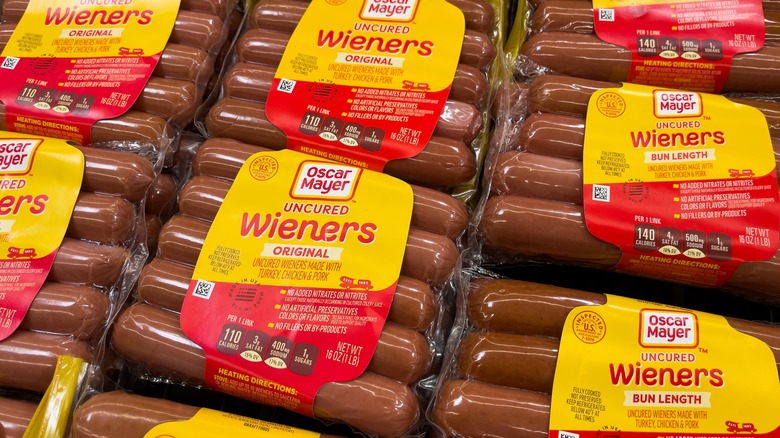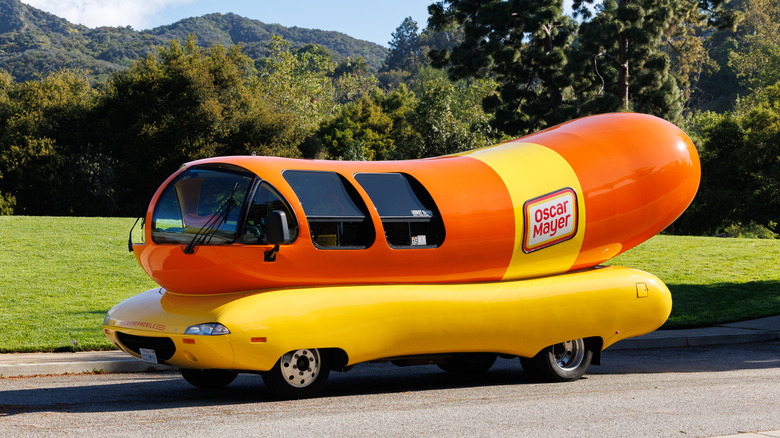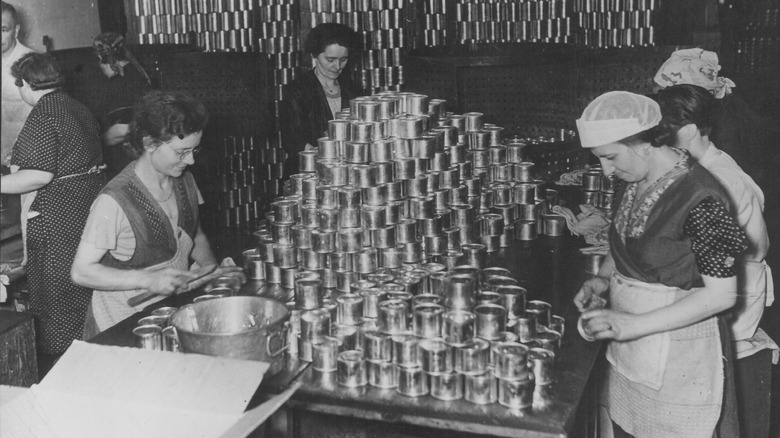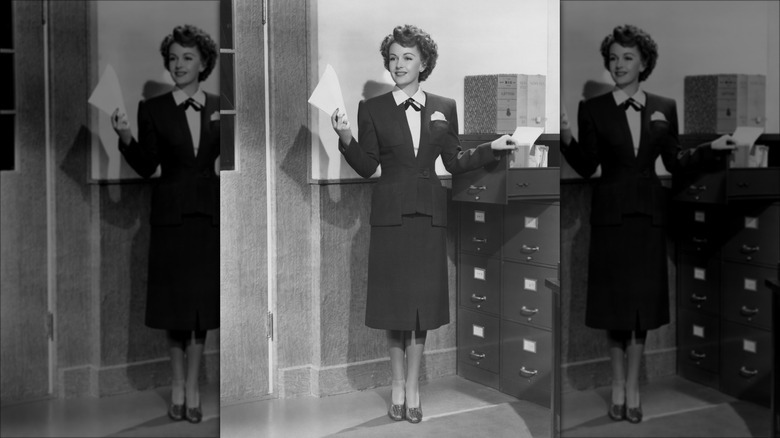The Weird And Wonderful History Of Oscar Mayer Hot Dogs
"Oh I wish I were an Oscar Mayer wiener." So sang millions of people, not only across the U.S. but also around the world. That company jingle firmly established the iconic hot dog brand as a force to be reckoned with in the meat-packing world, one musical bar at a time. The Oscar Mayer Company was founded by German immigrant Oscar F. Mayer in Chicago's meat market in 1883 (long before Sabrett, the iconic brand behind New York-style hot dogs). The company first established its roots among the German community in the Windy City. However, outside forces — in the form of the Chicago World's Fair in 1893 and World War I from 1914 to 1918 — boosted the popularity of the common hot dog to cultural phenomenon. Of course, that famous earworm, which appeared in commercials in the 1960's, didn't hurt the company's chances at popularity, either.
In the modern era, the Oscar Mayer brand is a Kraft Heinz subsidiary and now boasts plant-based hot dogs on its proverbial menu. Still, despite the foray into vegan fare, Oscar Mayer's frank always get the company's own unique brand of advertising, including special promotions done by its Wienermobiles and their crews of Hotdoggers. It's probably safe to say that Mayer never envisioned his company selling hot dogs made of plants and hot dog straws inspired by an internet meme as part of its line-up, and yet, there it is. The company's history is one that's as weird as it is wonderful. Here's a closer look.
The Wienermobile rolls onto the scene
Ardent foodies understand that the culinary world intersects with just about every aspect of life that there is, including transportation, and there may be no more jolly representation of this than the Oscar Mayer Wienermobile. Introduced in 1936, this Depression-era, hot-dog-shaped vehicle became a rolling advertisement for German-style wieners. It also created opportunities for company spokespeople to fraternize with the public at grocery stores, parades, and other events. This is how Oscar Mayer became a popular brand on grocery store shelves.
General Body Company of Chicago, Illinois, created the design for the first version of the vehicle. Eventually, a number of different car brands provided the chassis for the rolling dog, including Dodge, Ford, and Jeep. The original measured 13 feet in length. Today, a fleet of 27-foot vehicles driven by a cadre of promoters — Hotdoggers — brings smiles to streets across the U.S. The orange and yellow hot-dog-shaped vehicle has been on and off the road since its inception. Gas rationing removed it from the roads during the years of World War II, and the 2020 pandemic sidelined it for a time, too.
The interior of the Wienermobile inspires as much awe as its exterior. Hot dog illustrations decorate the backs of plush seats. Refrigerators, microwaves, and other accouterments ensure that the college-aged Hotdoggers are well-equipped. Hotdogger training includes time behind the wheel to learn how to turn around, though some reports suggest that the vehicles are designed so well, they turn around just as easily as a regular car. Parking, however, presents its own share of challenges.
The company answered the call to the war effort
The companies whose quirky food ideas gained prominence in the 1950s were the same outfits that fed the troops during the 1940s. During that era, Oscar Mayer shifted its focus to canned meats to aid with the war efforts. Calling its meat products "fighting food," the company kept up with its wartime demands by introducing new technologies — as well as innovations to distribution and packaging — to the meat packing business. The company's research division came into existence in 1941. Organized quality control followed not long after that. And the company's Kartridg-Pak, which came on the market in 1944, bunched hot dogs into bands, which were eventually decorated by its iconic yellow brand band.
Despite the strides it made during this time, the Oscar Mayer Company didn't keep these innovations to itself — it shared them with its competitors. It's also worth noting that the company's war efforts didn't begin with World War II. The company's involvement in World War I allowed it to expand its market reach significantly and helped to establish the hot dog, a cultural import from Germany, as an iconic American food.
The Oscarettes form their own club
In the spring of 1947, a blurb about the Oscarettes appeared in the Wisconsin State Journal. The group, which was a club formed at the Oscar Mayer plant in Madison, Wisconsin, took members from the ranks of women who had been employed by the processed meat company for at least two years. Eventually, that number changed to five years.
The Oscarettes (and other women like them) were part of the minority who worked outside the home after World War II came to an end. The Digest, a monthly publication of the National Bureau of Economic Research, reports that by 1947, almost 32% of women worked outside the home, compared to the nearly 87% of men during the same timeframe. But the Oscar Mayer company itself was a bit unusual — it actively sought out female workers, even in the earliest days of its existence. By 1920, it ran employment ads in the Wisconsin State Journal and The Capital Times, encouraging both men and women to apply for work. While the Oscarettes attracted female office workers, throughout the company's history, particularly during World War II, women worked in all facets of the company's meat packing business, including meat inspection.
The hot dog jingle enters public consciousness
In 1962, the Oscar Mayer Company put out a call for contest entries. Up for grabs? Fame and glory in exchange for an earworm that the public couldn't get out of their heads. A Chicago-based jingle writer, Richard Trentlage, responded to the contest, which he heard about on the radio. Trentlage employed simple songwriting methods. He pulled out his tape deck to record the song, and his 11-year-old son and 9-year-old daughter sang the lyrics. His wife played the standup bass. The adman himself was on the banjo-ukulele. His lyrical inspiration came from his son's wish to be a "a dirt bike hot dog" (that's slang for "a cool kid"). Who knew that the play on words would turn the Oscar Mayer wiener song into a new kind of cool, but it did just that.
Millions of kids in the '60 and '70s (and even beyond) enthusiastically sang along with the tune during commercials. The song became iconic, even earning a mention by Denis Leary in the movie "Demolition Man" and a musical skit on "The Simpsons." When it was all said and done, nearly 50 million families were exposed to Trentlage's famous tune in its heyday, and thanks to its release, the hot dog giant finally reached national distribution.




